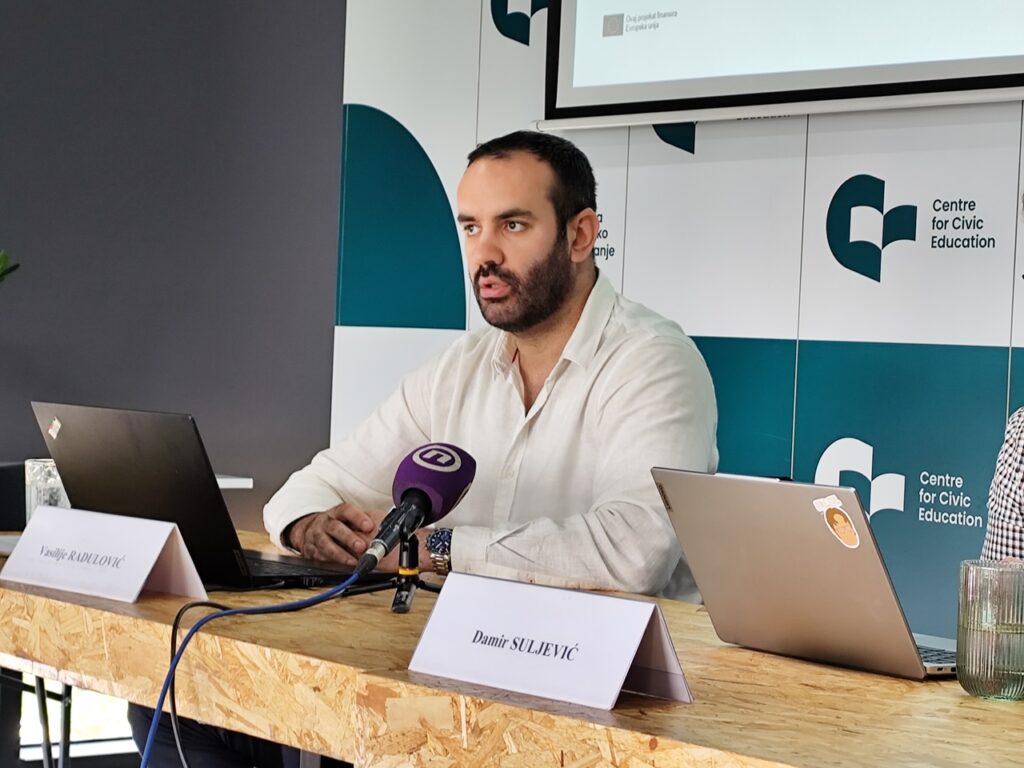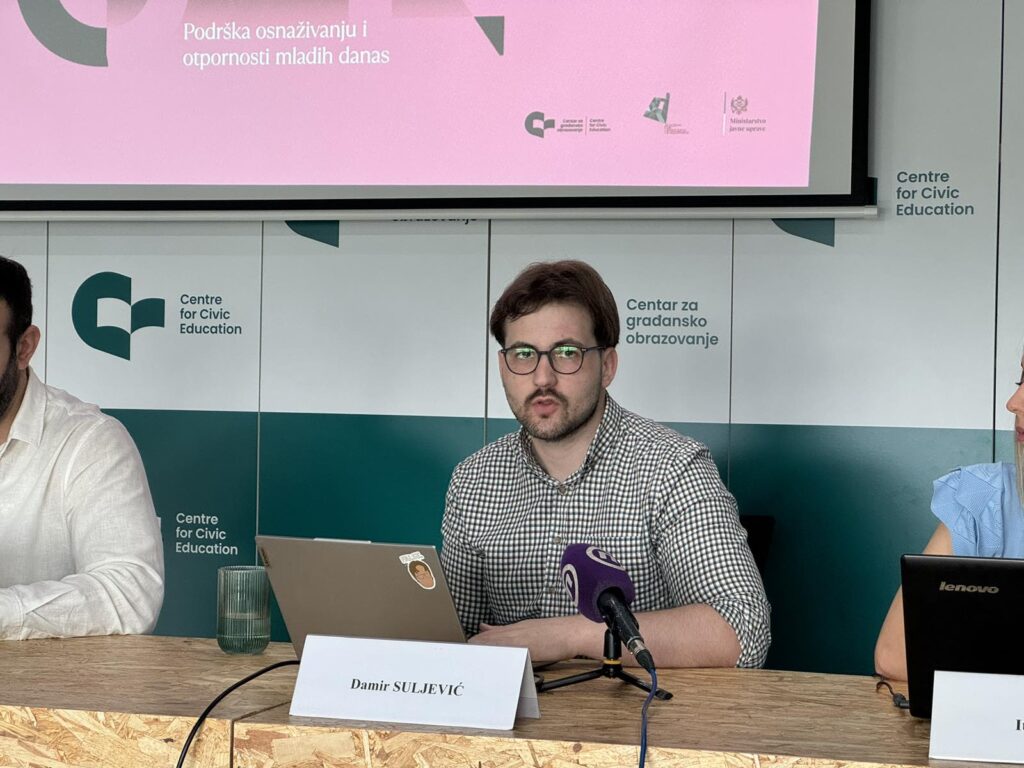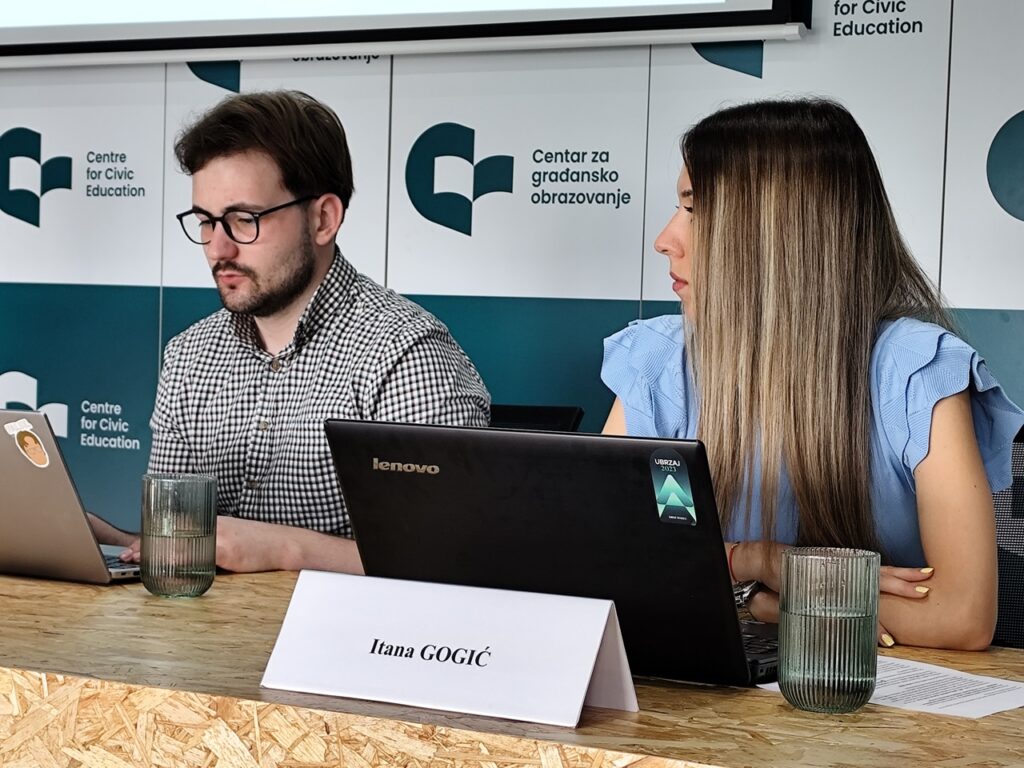Peer violence is widely perceived both among high school students and the general population. Every fifth student reports being a victim of violence, and 53.4% know someone who has been a victim of peer violence. The most common forms of peer violence in schools are psychological and physical violence. Among students who have been victims, 64.2% reported the violence, while 35.8% did not. Adult respondents hold parents most responsible for the peer violence committed by their children, and the vast majority believe that media and social networks influence the occurrence and development of juvenile delinquency and peer violence. These are some of the findings from two parallel surveys on the perception of peer violence and juvenile delinquency among adult citizens of Montenegro, as well as among the high school population, presented today by the Centre for Civic Education (CCE) as part of the project “HEART: Helping Empowerment and Resilience for Today’s Youth,” financially supported by the European Union with co-financing from the Ministry of Public Administration.
Vasilije Radulović, programme associate at CCE, presenting data related to the high school population, said that nearly 60% of students recognize some degree of peer violence presence in their school or community, while only 11% believe it is absent in their environment. Additionally, findings indicate the most frequent presence of psychological and physical violence, followed by social and digital violence, and to a lesser extent, sexual violence.

“Every fifth student (21.6%) stated they had been a victim of peer violence, while 78.4% had no such experience. Victims most frequently experienced psychological (34.9%), social (22.4%), and digital violence (17%). Simultaneously, 15.8% of students reported experiencing physical violence, and 9.9% reported sexual violence. For peer violence in their communities, they consider families and family upbringing most responsible, along with the Internet and social networks, as well as the general state of society,” said Radulović.
The causes of peer violence are diverse, but the main ones include peer influence, family problems, substance abuse such as drugs and alcohol, and access to and exposure to media and the internet without supervision.
Among students who were victims of violence, 64.2% reported it, while 35.8% did not. Among those who did, the majority reported it to a family member and school, then to a friend, police, or an NGO.
The research showed that 53.4% of students know someone who has been a victim of peer violence, and half of those who know victims reported that the victims reported the violence. Over 66% of students have witnessed peer violence at some frequency and mostly reported it, while about 33% stated they have never witnessed it.
“Over four-fifths of students stated they would report peer violence if they were victims, while about one-fifth would not, indicating the need for additional education and support. Also, among students who have not witnessed peer violence and would not report it to the school, 75.9% believe nothing would change,” said Radulović.
Every fifth student knows someone in their school or community who has been convicted of a crime as a minor.
Students mostly feel safe at school, with about 9% saying they do not feel safe there.
The majority (51.0%) believes that measures against peer violence are being implemented but that there is significant room for improvement.
“Students believe that peer violence in school or the community can be curbed by stricter penalties from institutions for those who commit violence and stricter school penalties. Workshops on the prevention of peer violence are also seen as useful, along with better availability of psychological-pedagogical services and introducing option of school police officers,“ explained Radulović.
“Nearly two-fifths of students (39.1%) reported feeling offended or hurt by a comment or picture posted by one of their peers or acquaintances on social networks (Instagram, TikTok, Snapchat, Facebook, X), while 60.9% did not have such an experience,” he said.
The research reveals that 16.6% of students admitted to having engaged in peer violence at some point, while 83.4% have never been involved in such behavior.
Damir Suljević, a program associate at CCE, presented findings related to the adult population, noting that over three-fifths of respondents believe peer violence is occasionally or frequently present, while less than a third think it is rare. Similar data applies to the presence of juvenile delinquency, with over 55% of citizens believing that crimes committed by minors are occasionally or frequently present, while about a third think it is rare, and about 10% believe it is absent in their environment.
“Social and family factors have the most significant impact on juvenile deviant behavior, but the influence of educational, economic, geographical, and health factors is also recognized. The most common forms of peer violence are psychological and physical violence, followed by digital, social, and sexual violence,” said Suljević.

The findings indicate that most respondents have not personally experienced peer violence, but nearly a fifth have been victims, mostly of psychological and physical violence. A significant number of respondents know someone who has been a victim of peer violence.
“The overwhelming majority of respondents said they have never committed peer violence, while every tenth admitted to past bullying. Most of those who admitted to committing peer violence reported being punished by relevant institutions, but a similar number avoided punishment. Also, most who admitted to committing peer violence claim they would not repeat it, although 16% said they would do it again. While most perpetrators of peer violence regret their actions, this smaller percentage may not be aware of the seriousness of their actions or do not feel remorse,” explained Suljević.
The prevalence of juvenile delinquency is also confirmed by the fact that every fourth respondent knows someone who was convicted of a crime as a minor.
“The majority belief is that sanctions for juvenile delinquency and peer violence are mild or very mild, and they should be tightened to contribute to more effective suppression of juvenile delinquency and peer violence. It is interesting that there is immense support for the introduction of the school police officer institute (72.1%),” said Suljević.
Opinions are divided on the effectiveness of alternative sanctions compared to conventional ones, and the majority believe that existing policies and programs for suppressing juvenile delinquency are not effective. Over 50% of respondents rate the response of competent authorities to the issue of juvenile delinquency as poor or very poor, while slightly over 37% rate it as good or very good.
“The dominant majority (74.1%) believes that the media influence the occurrence and development of juvenile delinquency and peer violence, while the percentage is even higher for the influence of social networks – as much as 85.9%. This is instructive for further consideration of measures and strategies to manage their impact to reduce the rate of juvenile delinquency and peer violence,” said Damir Suljević.

More than half of the respondents who are parents of school-age children (58.8%) trust the school to protect their child in case of peer violence and believe their children are safe at school.
“There is a high degree of agreement that parents have a crucial role in preventing and addressing peer violence. Thus, 79% consider parents responsible for the peer violence committed by their children,” said Suljević.
“The main causes of peer violence, as seen by citizens, include peer influence, access to and exposure to media and the internet without supervision, family problems, substance abuse, and the absence or lack of positive role models, as well as lack of educational opportunities, mental health, and emotional problems. These data highlight the complexity of the problem of peer violence, which results from a combination of various social, family, and individual factors, emphasizing the need for a comprehensive approach in preventing and addressing this issue,“ he concluded.
The research was conducted on two levels – a stratified three-stage sample of 1,000 high school students aged 15 to 19 from 4 to 15 June 2024, and a stratified three-stage sample of 1,000 adult citizens of Montenegro surveyed from 5 to 14 June 2024, using the CAPI method. The Institute DAMAR provided professional support in conducting this research.
Maja Marinović, Program Associate
